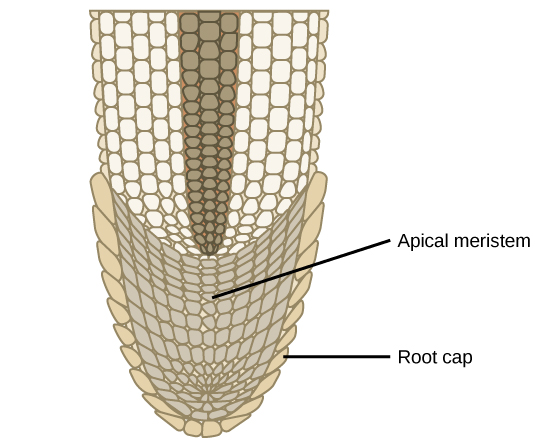| << Chapter < Page | Chapter >> Page > |
Gametangia (singular, gametangium) are structures observed on multicellular haploid gametophytes. In the gametangia, precursor cells give rise to gametes by mitosis. The male gametangium (antheridium) releases sperm. Many seedless plants produce sperm equipped with flagella that enable them to swim in a moist environment to the archegonia: the female gametangium. The embryo develops inside an archegonium into a multicellular sporophyte. Gametangia are prominent in seedless plants, but are very rarely found in seed plants.
Shoots and roots of plants increase in length through rapid cell division in a tissue called the apical meristem, which is a small zone of cells found at the shoot tip or root tip ( [link] ). The apical meristem is made of undifferentiated cells that continue to proliferate throughout the life of the plant. Meristematic cells give rise to all the specialized tissues of the organism. Elongation of the shoots and roots allows a plant to access additional space and resources: light in the case of the shoot, and water and minerals in the case of roots. A separate meristem, called the lateral meristem, produces cells that increase the diameter of tree trunks.

As plants adapted to dry land and became independent from the constant presence of water in damp habitats, new organs and structures made their appearance. Early land plants did not grow more than a few inches off the ground, competing for light on these low mats. By developing a shoot and growing taller, individual plants captured more light. Because air offers substantially less support than water, land plants incorporated more rigid molecules in their stems (and later, tree trunks). In small organisms such as single-celled algae, simple diffusion suffices to distribute water and nutrients throughout the organism. However, for plants to evolve larger forms, the evolution of vascular tissue for the distribution of water and solutes was a prerequisite. The vascular system contains xylem and phloem tissues. Xylem conducts water and minerals absorbed from the soil up to the shoot, while phloem transports food derived from photosynthesis throughout the entire plant. A root system evolved to take up water and minerals from the soil, and to anchor the increasingly taller shoot in the soil.
In land plants, a waxy, waterproof cover called a cuticle protects the leaves and stems from desiccation. However, the cuticle also prevents intake of carbon dioxide needed for the synthesis of carbohydrates through photosynthesis. To overcome this, stomata or pores that open and close to regulate traffic of gases and water vapor evolved in plants as they moved away from moist environments into drier habitats.

Notification Switch
Would you like to follow the 'Principles of biology' conversation and receive update notifications?